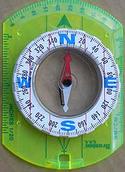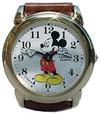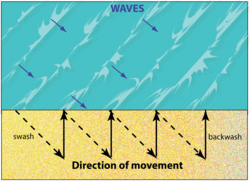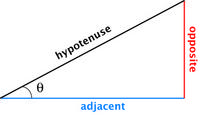Trigonometry and Angles
Geologic context:
Trigonometry and Angles
Jump down to: Teaching strategies | Materials & Exercises | Student ResourcesWhat's so hard about angles and trigonometry?
An understanding of angles and the ability to manipulate trigonometric expressions is essential for the introductory geoscience student. Geoscientists use both of these concepts in numerous applications, from coastal geology to mineralogy to geologic mapping. Helping students to develop the tools they need to understand these important concepts can be challenging. Most college students have learned about trigonometry at some point in their high school career (remember "soh, cah, toa? sin = opposite/hypotenuse..."); however, moving beyond the abstract mathematics to application is often difficult for the student.Teaching Strategies: Ideas from Math Education
Put quantitative concepts in context
- Geologic structures and mapping
- Compass direction, strike and dip
- Ocean and seismic waves
- Dunes, wind direction and currents
- Subduction zones
- Slope stability
- Planetary applications (parallax)
Use multiple representations
Because everyone has different ways of learning, mathematicians have defined a number of ways that quantitative concepts can be represented to individual students. Below are some ways that angles and their relationship to trigonometry are used in geoscience concepts.
- graphical/visual representation
- This distinction may seem superfluous since in trigonometry an angle of 90° give the same results no matter the direction. However, the distinction between right- and left-hand coordination systems becomes extremely important for map reading (particularly when we get to reading structural information from a geologic map). To avoid confusion, a simple discussion of the distinctions between map angles and math angles is worthwhile before beginning an exercise in which students have to use structural information.
- Students who are uncertain of their math skills will need help with the idea of a coordinate system. Giving students a compass (a sketch on paper will do) with angles and directions labeled on it may help them to visualize the organization of the coordinate system used in geology.
- On the other end of the spectrum, students who have taken a number of math courses (particularly trigonometry) will need help adjusting to a new system. Taking time to explain the organization in relation to a clock (something that all students can relate to) may help them to make the transition.
- numerical representation/angle units
- As discussed above, geologists (and sometimes mathematicians) generally use degrees for measurement of angles. A circle has 360° total; a right angle is 90°. The orientation of 0° and other angles varies for geologic and mathematical applications (see graphical representation). Geologists use circle geometry to talk about compass directions where 0° is at 12 o'clock and angles increase in the clockwise direction.
- Geoscientists also talk about angles in degrees when we talk about orientation of one line (or vector) to another. Examples of this include: relative plate motions, wave propagation and slope stability. For these applications we use triangle geometry to describe these directions.
- Mathematicians often use radians to measure angles. The radian is the standar unit of angular measurement. Radians are units of angular measure defined such that the circumference of a unit circle (with a radius of one) is equal to 2π (in other words, one radian is equal to 180/π or approximately 57.3 degrees). An entire sweep around a unit circle is 2π radians; thus, a right angle is π/2 radians. Radians are rarely used in geoscience - the most common problem that students encounter is that they have not changed their calculators to degrees.
- symbolic representation
- physical representation




cos θ = adjacent/hypotenuse
and
tan θ = opposite/adjacent where θ is the angle of interest; opposite, adjacent and hypotenuserepresent sides of the triangle. See figure at right for illustration of right triangle geometry.

To expand on the physical model and include some mathematical calculations, trigonometry could be added to an exercise on angle of repose using the mass of an object placed on the board. Trigonometry can be used to calculate the normal force and the shear force exerted on the object for a given angle.
Use technology appropriately
Students have any number of technological tools that they can use to better understand quantitative concepts -- from the calculators in their backpacks to the computers in their dorm rooms. Students can make use of these tools to understand both right triangle geometry and trigonometric functions.
- Graphing calculators
- Computers
Work in groups to do multiple day, in-depth problems
Mathematicians also indicate that students learn quantitative concepts better when they work in groups and revisit a concept on more than one day. Therefore, when discussing quantitative concepts in entry-level geoscience courses, have students discuss or practice the concepts together. Also, make sure that you either include problems that may be extended over more than one class period or revisit the concept on numerous occasions.
Geoscience concepts reinforce trigonometric functions numerous times within one introductory course. Topics include angle of repose, wave refraction, the behavior of seismic waves in the Earth and measuring strike and dip. A detailed discussion is necessary when the concept is first introduced and some mathematical review will likely be necessary. However, when another topic related to trigonometry comes up, remind students of topics where the same mathematical skill is useful. Students are more likely to retain mathematical material when they see connections among topics.
Teaching Materials and Exercises
- Modeling the interior of the Earth using Seismic Waves Students use trigonometry to solve Snell's law for seismic wave refraction and determine the properties of the Earth's layers.
- An assessment of Hillslope Stability In this activity, students consider the balance of forces on a hillslope using the Factor of Safety by calculating shear stress and shear strength for an example hillslope and formulating an expression for the factor of safety in an Excel spreadsheet.
- Rock Density - some applications This activity includes several calculations using density to assess slope stability.
- Scaling Galileo's solar system An activity that uses a square mile to scale the inner planets of the solar system. Trigonometric functions figure prominently in the calculations using Excel.
Student resources
- MathWorld has dozens of pages relating to trigonometry (more info) , including some examples of problems and applications.
- S.O.S. Mathematics has a trigonometry index (more info) , featuring a table of trigonometric identities, lessons on functions and formulae, and a section of exercises and solutions.
- Math Help's trigonometry index (more info) provides a good refresher on basic trig identities, functions and angles. Also includes diagrams for unit circle and triangle trigonometry.
- Maths online (from Austria) has some java resources to help students understand trigonometric functions.
- The AP Calculus class at Batesville High School in Indiana has a Trigonometry Review with questions about right triangle trigonometry.








